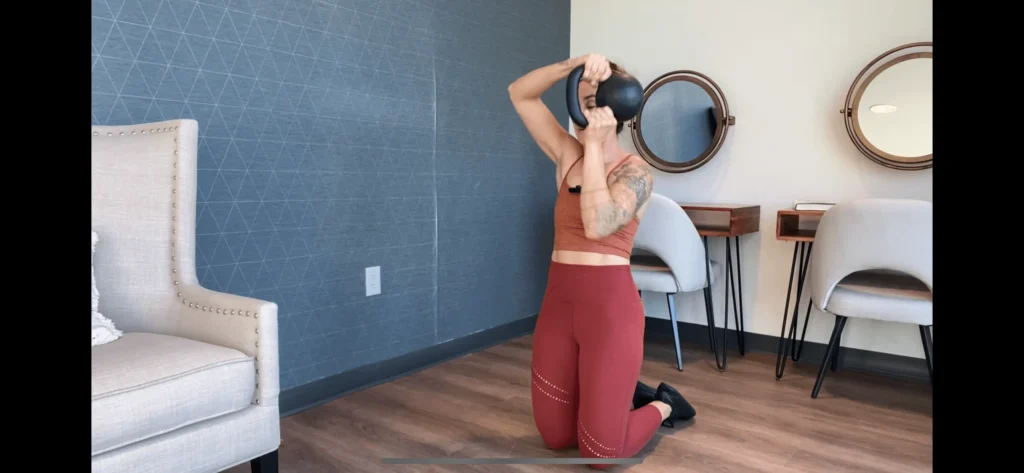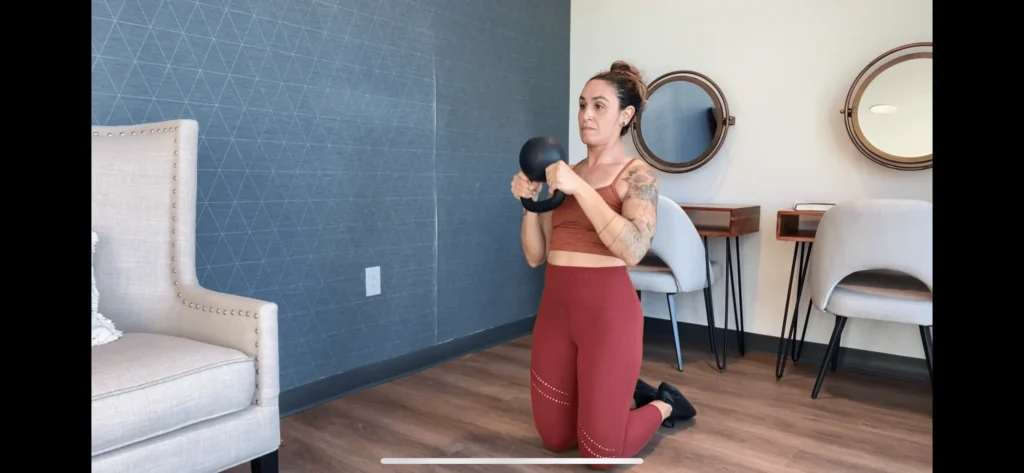Disclaimer: Our content doesn't constitute medical or fitness advice. We may be earning money from companies & products we review. Learn more
Want to get a wicked strong core without doing endless crunches? Enter the Kettlebell Halo.
This functional exercise involves circling a kettlebell around your head in a controlled manner that engages your core, shoulders, back, and arms. The kettlebell halo is a dynamic movement that should be a part of any strength training routine and is often used in kettlebell workouts to improve shoulder mobility, stability, and strength.
While kettlebell halos are often relegated to the “warm up” part of a workout, I’m an advocate of incorporating halos into your main workout routine too. As long as you maintain proper form and don’t use too much weight, you can get a killer shoulder workout with kettlebell halos.
Table of Contents
How to Perform Kettlebell Halos





Starting Position: can be standing, kneeling on one knee, or with both knees on the floor. All are variations of the same movement.
- Stand with your feet shoulder-width apart.
- Hold a kettlebell by the horns (the sides of the handle) with both hands, bringing it close to your chest.
- Brace your core to stabilize your torso.
- Lift the kettlebell to chest height.
- Start to circle the kettlebell around your head in a controlled manner. Make sure you stack your joints with your wrists over elbows on either side of your head.
- As you circle the kettlebell, keep it close to your head, and maintain a smooth and controlled motion. Only move the kettlebell, not your head or body.
You can perform the halo in both directions (clockwise and counterclockwise) to ensure balanced shoulder engagement.
Muscle Groups Targeted by Kettlebell Halos
The kettlebell halo is often used as a warmup drill for improving shoulder and rotator cuff mobility. However, halos don’t stop there—they target a range of muscle groups that, together, greatly improve one’s upper body power. The three main muscle groups targeted by kettlebell halos are:
- Core (strength and stabilization)
- Shoulders
- Upper back
In addition to directly strengthening the above muscle groups, kettlebell halos also bolster shoulder mobility, full-body strength, and overall stability throughout the body. Because they’re so versatile, I recommend adding this handy exercise to your at-home exercise routine.
Common Issues with Kettlebell Halos
As a personal trainer, the most common mistake I see clients make with kettlebell halos is when they try to move their head, neck, or body around the kettlebell rather than the kettlebell around their head and neck. Instead, your head and neck should stay completely locked into place with a neutral spine, controlled spine.
For injury prevention tips, I recommend giving this awesome StrongFirst article a read. If you can get your form down, it’s super unlikely that you will run into any serious problems while performing kettlebell halos.
To build strength, start with a lighter bell and go heavier as you become more stable. If you experience any pain whatsoever, stop what you’re doing and try a lighter weight. As a rule, this exercise is best performed with light, easily manageable weights.
Historical Fact About Kettlebell Halos
The kettlebell halo, although not directly tied to a specific historical event, draws inspiration from traditional Indian clubs. Indian clubs were exercise tools used in ancient Persia and spread to Europe in the 19th century. The circular motion of the halo mirrors some elements of Indian club exercises.
Master the Kettlebell Halo with a 1-on-1 Coaching Consult
The kettlebell halo is a great core strengthening exercise because it’s simple, sneaky, and effective. It’s also great at advancing your shoulder mobility because it forces dynamic movement in the joint at every angle. It’s a functional movement that mobilizes and strengthens at the same time.
The kettlebell halo is a worthwhile movement for many reasons but, in a nutshell, I recommend it to my clients because it helps improve stability, mobility, and upper body strength.
To supplement your kettlebell halo training, consider diversifying your kettlebell workouts with key accessory exercises such as the kettlebell clean.
Ready to integrate the kettlebell clean into your at-home fitness routine? If so, consider booking a consultation with one of our qualified trainers to learn how to perform this movement in a way that works for your unique body and movement style. Give it a shot today!

Helya is a NASM certified personal trainer with expertise in RKC, 200 Hr Yoga, Animal Flow, Precision Nutrition, Tabata, Pilates, and is currently completing her CrossFit L1 certification. She is an experienced coach with many certifications, but most of her experience comes from the hundreds of people she has helped over the last decade while owning a small functional training gym in Ventura, California. Helya is a people person passionate about helping people move well and hurt less.
